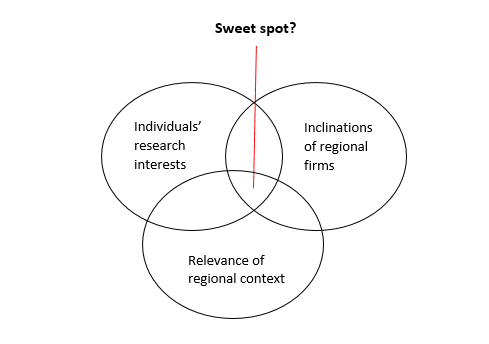
The concept of engagement in academe is in vogue! With much research focused on a myriad of issues around this concept – my research project alongside 13 others within the RUNIN project offers a good place to survey the landscape. Networks, partnerships, collaborations, interactions, relationships and linkages – a few of the core lingua embedded within the concept of engagement emphasize the value in maintaining a ‘flow’ between various stakeholders. Suffice to say, a flow of ideas, resources, and often people is imperative for engagement occurring at various levels such as individual and organisational. Engagement is also observed on different geographical scales: regional, national and international.
While universities as institutions have often struggled or even failed to offer the assistance required by academics’ engagement, they [academics] nonetheless continue to engage. Based on my on-going research on university-industry engagement (see Ahoba-Sam, 2019), it is apparent that academics’ decision to engage often boils down to the presence of a differentiating factor or a unique selling point (USP) that promises competitiveness, competence, access to resources, etc. But how are the unique offerings of a given region manifest to an academic who seeks local engagement? From a regional perspective, let us consider Individuals, Firms and the regional context as the embodiment of unique offerings for regional engagement.
…..Unique Individuals
As far as academic engagement goes, it is not adequate to simply collaborate. Striking connections with the right people is also important since people have unique combinations of knowledge, expertise and experience. Further, while knowledge should not be geographically bounded it is indeed regional and held tacitly by individuals who remain in certain regions. (Almeida & Kogut, 1999). As seen from the example of Silicon Valley, a concentration of human capital of a certain kind serves to attract others to the region. Suffice to say, the presence of knowledgeable individuals of a certain kind who could potentially impact the research of an academic encourages regional engagement
…..Unique firms
Academic scientists are driven to collaborate in order to advance their research agenda (D’este & Perkmann, 2011). When this collaboration is with industries, problem-solving forms the highlight of their activities. By this a win-win situation is imminent –industry problems are solved while the academic can obtain funding, etc. to further their research and exchange knowledge. In the course of my research, I have come across academics who had no local industry collaborations because, the local industries ‘were not relevant for their kind of research’ or ‘were not interested in their research area’. An important condition therefore is that regional firms should be of relevant industries that academic scientists are linked to, must be interested in local academic research as applicable to their processes and be willing to collaborate regionally. For the academic scientist, the prospect of forging relevant partnerships drives academics’ engagement with industry.
…..a Unique region
The competitiveness of regions is enhanced by region-specific assets that are hard to transfer or replicate in other places. These regionally-embedded advantages could be constructed (e.g. the region’s knowledge capacity built through knowledgeable individuals) or non-constructed (e.g tradable initial resource endowments) (Cooke & Leydesdorff, 2006). When a region is endowed with a natural resource, such as oil & gas, firms of relevance cluster around this resource. As evident from my research (Ahoba-Sam, 2019), individual academic scientists are also encouraged to move to such regions. Evidently, regions in themselves are presented as unique offerings when they provide a place of relevance for University-Industry (U-I) engagement.
…..a ‘sweet spot’ for U-I engagement?
Region-specific advantages, both constructed and non-constructed, present the primary distinction between researchers who are motivated specifically for regional engagement and those who are not. Regional actors who find these advantages irrelevant as far as their interests go may seek partnerships elsewhere, while those who find these advantages relevant are motivated to engage locally. It is important that all the facets (in this case Individuals, Firms and the Region) possess the right offerings required to drive engagement at the regional level – to create a sweet spot for regional engagement!

Fig. 1: ‘Sweet spot’ for regional engagement (after Ahoba-Sam, 2019)


